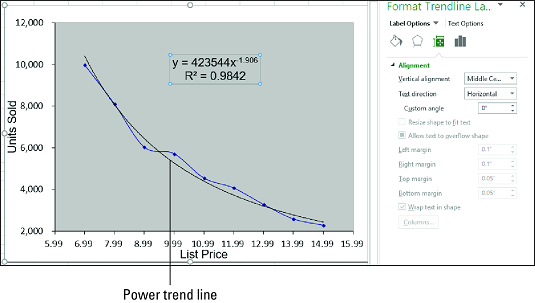

a and b are the parameters of the function found by the least squares method (also named function coefficients or constants),.The logarithmic trendline is a curved line with the function: Logarithmic trendline equation and formulas
 a dependent or response variable y (named as known_y's).
a dependent or response variable y (named as known_y's).  an independent, predictor, or explanatory variable x (named as known_x's),. If const is FALSE, the parameter a is set to 1, so the formula will look like y = e bx.Excel uses the least squares method to fit a trend line to the data points.įor a trend line, two sets of variables are required:. If const is TRUE or omitted, the parameter a is calculated normally,. Those, the curved line would pass through the point ( x = 0, y = 1): const (optional) is a Boolean value specifying whether to force the parameter a (intercept) to equal 1. If known_x's is omitted, it is assumed to be the array that is the same size as known_y's. known_x's (optional) are independent data values. known_y's (required) are dependent data values,. The array function LOGEST () calculates the exponential curve that fits best the known data and then returns an array with statistics describing the trend line: The array function LINEST () calculates the linear trend best fits the known data and then returns an array with statistics describing the trend line: To find parameter a, it is necessary to perform the inverse transformation a = EXP (A) or EXP (-A).Įxcel offers the following functions to calculate the trend parameters: For a < 0 (there is some upper bound c for y), the variables change to Y = ln ( c - y) and A = ln ( -a).
an independent, predictor, or explanatory variable x (named as known_x's),. If const is FALSE, the parameter a is set to 1, so the formula will look like y = e bx.Excel uses the least squares method to fit a trend line to the data points.įor a trend line, two sets of variables are required:. If const is TRUE or omitted, the parameter a is calculated normally,. Those, the curved line would pass through the point ( x = 0, y = 1): const (optional) is a Boolean value specifying whether to force the parameter a (intercept) to equal 1. If known_x's is omitted, it is assumed to be the array that is the same size as known_y's. known_x's (optional) are independent data values. known_y's (required) are dependent data values,. The array function LOGEST () calculates the exponential curve that fits best the known data and then returns an array with statistics describing the trend line: The array function LINEST () calculates the linear trend best fits the known data and then returns an array with statistics describing the trend line: To find parameter a, it is necessary to perform the inverse transformation a = EXP (A) or EXP (-A).Įxcel offers the following functions to calculate the trend parameters: For a < 0 (there is some upper bound c for y), the variables change to Y = ln ( c - y) and A = ln ( -a).  For a > 0, the variables change to Y = ln ( y) and A = ln ( a),. After changing the variables, the calculations are similar to the linear case Y = b * x + A: Note: Excel uses a linear model to fit an exponential function: the exponential function y = a * e bx is transformed into a linear function using a change of variables. the result of EXP (1) - see below the description of this function). e is the mathematical constant, the base of the natural logarithm (also known as Euler's number, approximately equal to 2.71828. a and b are the parameters of the approximating function (also named function coefficients or constants),. The exponential trendline is a curved line described by the function: a dependent or response variable y (named as known_y's).Įxponential trendline equation and formulas. When calculating a trend line, two sets of variables are required: Excel uses the least squares method to find the best fitting line for the data points.
For a > 0, the variables change to Y = ln ( y) and A = ln ( a),. After changing the variables, the calculations are similar to the linear case Y = b * x + A: Note: Excel uses a linear model to fit an exponential function: the exponential function y = a * e bx is transformed into a linear function using a change of variables. the result of EXP (1) - see below the description of this function). e is the mathematical constant, the base of the natural logarithm (also known as Euler's number, approximately equal to 2.71828. a and b are the parameters of the approximating function (also named function coefficients or constants),. The exponential trendline is a curved line described by the function: a dependent or response variable y (named as known_y's).Įxponential trendline equation and formulas. When calculating a trend line, two sets of variables are required: Excel uses the least squares method to find the best fitting line for the data points.












